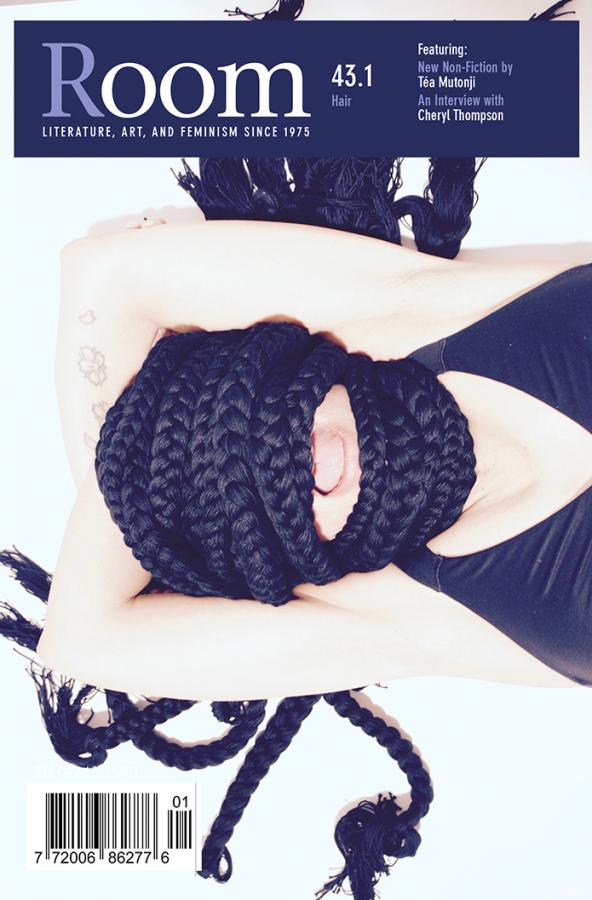Hair | 43.1
2020
Hair has shaped my entire life. When I knew I would be editing another issue of Room, my first thought was “it needs to be about hair.” Hair informs what I write, the way I write, who I write for, where I situate myself, and even how I fit in with my family. My own stories of hair are wrapped tightly around trauma and yes, abuse. I wanted to enter into this issue with an open mind. I wanted to include pieces that spoke to a wide sweeping scope—no two stories of hair are the same.
In the call for submissions, we asked for pieces that connected directly to the theme of hair, and stories that preached the broader themes of strength, power, and resilience. Hair breaks rules, and so does this issue. We start with a longer feature interview by Tamara Jong with Dr. Cheryl Thompson, author of Beauty in a Box. Together, they delve into the history of black women’s hair and in return we get to learn a bit more about what history doesn’t teach us. We get to hold the missing middles.
In commissioned writer Téa Mutonji’s essay, we accompany her on her personal hair journey. We bump up against the notion of what it truly means to accept, to move on, to heal—to start new.
Hannah McGregor’s essay, “Burning Out”, indirectly connects to the hair call via resilience and growth. In her essay I felt jolted and then rooted in the very prob- lems that can grow in our lives. They expand. We chop them down. They come back. She reminds all of us that anything alive—grows.
Hair can act as a container. It’s impossible to predict how much it can hold. In Unnati Desai’s poem “lagen season” the container swells as she gifts us family history through memory:
the building shakes with a shared family story
each new face forming an extension I can only trace back to my grandmother.
under the moonlight on the outdoor swing,
trailing her hands through my hair
my grandmother tells stories
stories of
all the bright coloured houses that came before this one
When I first saw Chantal Gibson’s cover image, it was empowering for me to see a mixed-race artist exhibit such confidence of self. In her artist statement she says:
“I remember I have a body. I am a text. Against a sheet of white paper, under cold, harsh studio lights, with the help of my art director, I hold the same black threaded braids that have held me for years—that have given me a voice. I’m not staring back, I’m looking within.”
In this issue we included an expanded BackRoom interview by Mridula Morgan in conversation with Zehra Naqvi about everything hair related but especially Muslim women and covering and not covering hair. Naqvi states: “A woman may cover her hair for a myriad of reasons: for religious purposes, as a political state- ment, a fashion statement, to fit in, to be visible, to be less visible, because that’s what she’s comfortable with and used to, out of rebellion, out of compliance, as an act of resistance, as an act of submission, for health reasons, all of the above, or none of the above, or the reasons may shift and change and vary throughout her life.”
These stories, statements, poems, and images are meant to be invitations into a conversation we should have been having a long time ago.
I invite all of you to look within, too.

$10.00 – $21.00
Additional information
| Delivery | Canada, USA, International, Digital |
|---|
In this issue: Nikka Cornelio-Baker, Sonja Boon, Kat Cameron, Jhilam Chattaraj, Chelsea Comeau, Unnati Desai, Kimberly Edgar, Sherine Elbanhawy, Kim Fahner, Chantel Gallagher, Chantal Gibson, Ali Jo, Samantha Jones, Tamara Jong, Chelene Knight, Angélique Lalonde, Shelby Lisk, Asli Mahdi, Hannah McGregor, Dene Moore, Mridula Morgan, Mily Mumford, Téa Mutonji, stephanie roberts, Zoe Imani Sharpe, Nadia Siu Van, Mallory Tater, Délani Valin, Carly Rosalie Vandergriendt, Cara Waterfall, Evelyn C. White, Adrianne Williams, Susan Wismer